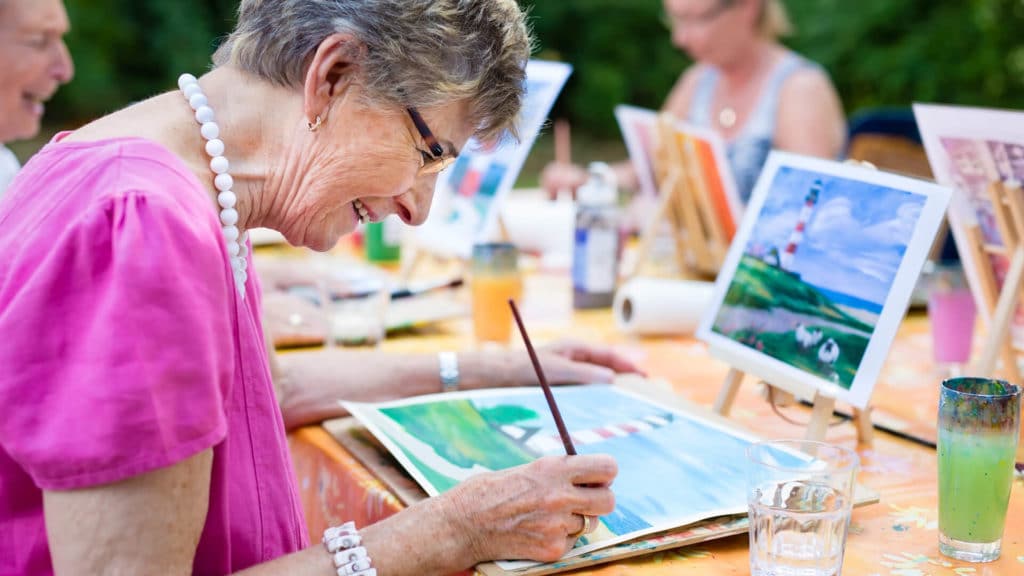Dementia can take away so much, which is likely why the focus of traditional memory care is on that which your loved one can no longer do. This is important., however, as your loved one isn’t one-dimensional, and their care shouldn’t be either. Learn about the benefits of an engagement-focused philosophy for memory care.
The Facts on Memory Loss
Many people assume dementia and Alzheimer’s disease are the same thing. In fact, Alzheimer’s is only one type of dementia; although it’s the most prevalent type.
Dementia is a category of diseases associated with memory loss and deterioration in other mental functions that affect daily life such as reasoning, communication, concentration and even visual perception. It’s caused by damage to brain cells and all types of dementia are progressive, meaning the symptoms get worse over time.
According to the Alzheimer’s Association, 5.8 million Americans are living with Alzheimer’s. By 2050, this number is projected to be nearly 14 million. Alzheimer’s disease typically progresses in three stages: mild (early stage), moderate (middle stage), and severe (late stage). Early memory loss is mild, but in the later stages a person may forget loved ones, how to dress themselves, feed themselves or carry on a conversation.
Alzheimer’s affects each person differently. The timing and severity of progression vary. This underscores the importance of multi-dimensional and individually tailored memory care programming.
Defining Engagement-Focused Memory Care
Because of the differences in symptom progression, people benefit most from a memory care environment built especially for them. An engagement-focused philosophy such as our Vital Brain Program is founded on the belief that everyone has an innate ability to learn and succeed no matter the degree of cognitive impairment. That’s why we focus on what your loved one can do or wants to do, not what they have lost. They can live their best life regardless of how far the disease has progressed.
Key components of our Vital Brain Program include:
- Daily opportunities to build cognitive strength
- Learning and experiencing new things
- Practicing stress reduction
Our daily schedule may have options like this:
| 9:30 a.m. | Lecture – Art Deco Architecture | Creative Art Storytelling |
| Noon | Mindful Meditation – Energize | Spanish Class |
| 3 p.m. | Virtual Art | Digital Photography Class |
| 4 p.m. | Podcast Club | Summer Concert in the Park |
| 6:30 p.m. | Using Facetime, Skype & Google Chat | Mindful Meditation – Relaxation |
In addition, we offer supportive care such as personal hygiene, reminders and medication assistance along with amenities such as private apartments, chef-prepared meals, transportation, housekeeping and maintenance services.
Our communities feature a neighborhood concept that’s secure and specifically designed for independence, engagement and success with lighting and colors chosen to be calming as well as access to fresh air and sunshine carefully incorporated.
Vital Brain Memory Care in Action
But perhaps the best way to show the benefits of an engagement-focused philosophy for memory care is to share some of our residents’ stories.
“One of the hardest things my family had to do was to bring our Mother to memory care. After seeing the nurses take care of her when she was sick and give her medicine to her daily. Watching the caregivers take care of her, talking with her, laughing with her even giving her nicknames. We now know it was the best thing for her.”
— Daughter of resident
“Mom’s experience has been great, especially the friendly staff who know her well and get her involved. It’s been wonderful. She has lived there almost a year and is thriving. We appreciate the warmth, love and friendliness.”
— Son of resident
“My mom and dad are both here. Mom is in the memory care community. I feel grateful they are both in such a compassionate place. My father likes to watch the birds in the courtyard and he visits my mom every day. Mom loves music and gets to participate in the musical events; she claps her hands and sings. It is wonderful to see her so delighted.”
— Son of resident
For more information on memory care, check out our Family Decision Guide!



